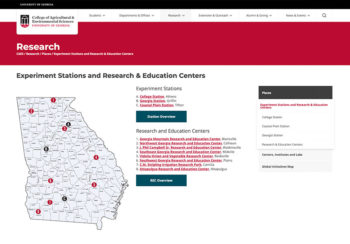Often, buying a home in a “good neighborhood” also means access to a good school. But as communities implement more school choice policies, that connection between schools and neighborhoods weakens.
This is according to a study co-authored by University of Georgia assistant professor Walker A. Swain, who teaches educational policy in the College of Education. When school choice policies are implemented without regard to a community’s racial or economic makeup, they can end up doubling the rate of gentrification in some of the most racially isolated neighborhoods.
“There’s this interplay between the school policy and the housing policy,” said Swain. “If you’re dealing with those two things in concert, then thinking about your student assignment plan for the neighborhoods drives how the housing works.”
The study, published in the journal Sociology of Education, used data from the 2000 and 2010 U.S. Census along with the National Center for Educational Statistics and the Schools and Staffing Survey. Swain and co-author Francis Pearman II, an assistant professor of urban education at the University of Pittsburgh, examined the relationship between expanded school choice and gentrification at the neighborhood level.
In a best-case scenario, school districts and communities work together to implement policies that help guide the integration of neighborhoods and schools across the entire community. It’s a balancing act, said Swain; for example, a district may consider a school’s enrollment based on student proximity along with other factors such as poverty rates.
North Carolina’s Wake County School System, for example, uses a “controlled-choice” plan to keep student poverty rates relatively equal across all schools. Families would be able to rank schools from among a given set, with assignments made by the district based on certain criteria. As a result, the process also caps schools’ poverty rate at 40 percent, just above that of the broader community. As a result, neighborhoods are less likely to get tagged as “less desirable” in connection with a particular school. “Gerald Grant wrote a book calling it the ‘No bad schools’ district, because you don’t have any high-poverty schools,” Swain added.
On the flip side, though, school choice policies made without any thought to community dynamics can quicken gentrification and quash school and neighborhood integration. In areas with broad school choice, for example, Swain and Pearman found families might move into an in-town neighborhood but send their children to a public school in another part of town. As a result, home prices rose and the neighborhood gentrified—but the nearby neighborhood school stayed much the same as before.
Prior research found that families who moved into these neighborhoods were also less likely to engage with neighbors. “And the rising home values often ultimately result in the displacement of communities that were living there initially,” said Swain. “As you see this play out, poverty is pushed to the suburbs and away from city centers.”
Swain noted that other research found the largest transformation in neighborhoods took place in major U.S. cities—Los Angeles, New York and Washington, D.C., for example. When looking at the country as a whole, the changes are small—but they do indicate the direction they are headed.
Often, communities consider educational needs and housing needs separately. For example, school board and city officials don’t typically work together on ways housing and school choice policies could overlap.
Hopefully, said Swain, this study might show the importance of that kind of collaboration.
“We have a much broader acceptance of the idea of equal access to schooling than we do equal access to housing, in spite of a lot of good work that has really highlighted how critical the role of housing, especially for children, is in terms of your development, your success, your ability to contribute to the economy in the long run,” said Swain. “But I think the more we think about the two problems together—segregated housing and segregated schooling—it exists on both sides.”






